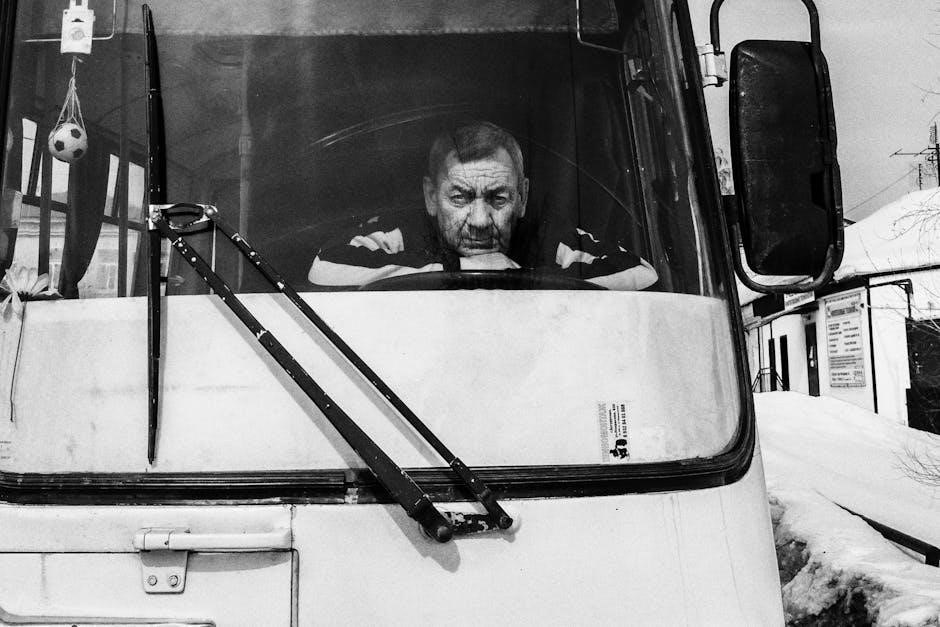Road safety education is crucial for reducing accidents and saving lives. It equips all road users with essential knowledge of traffic rules‚ signs‚ and safe practices‚ fostering a safer environment for everyone.
1.1 Importance of Road Safety Education
Road safety education is vital for equipping road users with the knowledge and skills to prevent accidents. It empowers drivers‚ pedestrians‚ and cyclists to understand traffic laws‚ recognize hazards‚ and make informed decisions. By learning about traffic signs‚ signals‚ and safe practices‚ individuals can significantly reduce the risk of collisions. Road safety education also fosters a culture of responsibility and mutual respect among all road users. Regular quizzes and resources‚ such as road sense questions and answers PDFs‚ provide interactive ways to test and reinforce this critical knowledge. Ultimately‚ education plays a key role in saving lives and creating safer communities worldwide.
1.2 Key Concepts in Road Safety
Key concepts in road safety include understanding traffic signs‚ adhering to speed limits‚ and following right-of-way rules. These principles ensure smooth traffic flow and minimize collision risks. Pedestrian safety‚ vehicle maintenance‚ and emergency procedures are also critical. Quizzes and resources‚ such as road sense questions and answers PDFs‚ help reinforce these concepts. They cover topics like safe distances‚ night driving tips‚ and cyclist rules. Regular testing ensures road users stay informed and vigilant. By mastering these fundamentals‚ individuals contribute to a safer road environment for everyone. Consistent education and awareness are essential for reducing accidents and saving lives.

Traffic Signs and Signals
Traffic signs and signals guide road users‚ ensuring safe navigation. They include warning‚ regulatory‚ and informational signs. Road sense questions and answers PDFs help users understand their meanings.
2.1 Types of Traffic Signs
Traffic signs are categorized into three main types: warning‚ regulatory‚ and informational. Warning signs‚ such as curve or pedestrian crossing alerts‚ prepare drivers for potential hazards. Regulatory signs‚ like speed limits or stop signs‚ enforce traffic laws. Informational signs guide drivers on directions or services. These signs are standardized for universal understanding. Road sense questions and answers PDFs often test knowledge of these categories‚ ensuring drivers recognize and interpret them correctly. Understanding each type is essential for safe driving and adhering to road rules. These resources help users master traffic sign recognition‚ enhancing overall road safety awareness and compliance.
2.2 Understanding Traffic Signals
Traffic signals are essential for organizing traffic flow and preventing accidents. They include red‚ yellow‚ and green lights‚ as well as arrow signals and pedestrian signals. Red signals indicate when drivers must stop‚ while green signals allow movement. Yellow signals warn of an upcoming red light. Arrow signals guide specific movements‚ such as left or right turns. Pedestrian signals indicate when it’s safe to cross. Road sense questions and answers PDFs often include multiple-choice queries about these signals‚ testing knowledge of their meanings and proper responses. Understanding traffic signals is vital for all road users to ensure compliance and safety. These resources help reinforce correct interpretations and behaviors at intersections and crossings.
Safe Driving Practices
Safe driving practices are essential for minimizing risks on the road. They include maintaining safe distances‚ adhering to speed limits‚ and being vigilant in various driving conditions; Road sense questions and answers PDFs often cover these topics to educate drivers and promote responsible behavior behind the wheel.
3.1 Following Safe Distances
Maintaining a safe distance from the vehicle ahead is a critical aspect of defensive driving. It allows drivers sufficient time to react and avoid potential collisions. According to road safety resources‚ the “two-second rule” is a widely recommended guideline. This means drivers should keep at least a two-second gap between their vehicle and the one in front during favorable conditions. In adverse weather‚ such as rain or fog‚ this distance should be increased to four or more seconds. Road sense questions and answers PDFs often emphasize the importance of adjusting following distances based on speed and road conditions to ensure safety for all road users.
3.2 Night Driving Tips
Night driving requires extra caution due to reduced visibility. Always use low beams when approaching other vehicles to avoid dazzling drivers. Ensure your windshield and mirrors are clean for clear vision. Reduce speed and increase following distances to allow more reaction time. Be aware of glare from oncoming headlights by looking toward the right side of the road. Keep an eye out for pedestrians‚ cyclists‚ and animals‚ as they may be harder to spot. Avoid using high beams in urban areas or when following another vehicle. Signal early and avoid sudden maneuvers. Keep your vehicle well-maintained‚ with functioning lights and wipers. These practices significantly enhance safety during nighttime driving.

Pedestrian Safety
Pedestrian safety is vital to prevent accidents; Always use designated crossings‚ follow traffic signals‚ and stay visible to drivers. Make eye contact with drivers before crossing roads.
4.1 Rules for Pedestrian Crossings
Pedestrians must follow specific rules when using crossings to ensure their safety. Always stop and wait when the pedestrian signal is red or when instructed by traffic signs. Use designated crosswalks and avoid jaywalking‚ as it increases the risk of accidents. When crossing‚ make eye contact with drivers to ensure they see you. Never cross at sharp bends or near stopped vehicles where visibility is poor. At traffic lights‚ only cross when the pedestrian signal is green. If there are no traffic signals‚ look left‚ right‚ and left again for oncoming vehicles before crossing. These rules help reduce accidents and ensure a safer environment for all road users.
4.2 Safety Tips for Pedestrians
- Always wear bright or reflective clothing to increase visibility‚ especially at night or in low-light conditions.
- Use sidewalks whenever available; if none exist‚ walk facing traffic and stay as far from the road as possible.
- Avoid distractions like using phones or listening to music while walking near roads.
- Make eye contact with drivers before crossing to ensure they see you.
- Never assume a driver will stop; always be prepared to react.
- Follow traffic signals and pedestrian lights; never cross against a red light.
- Stay alert at intersections‚ bends‚ and areas with limited visibility.
- Carry a flashlight or use reflective accessories when walking at night.
- Teach children basic road safety‚ such as holding hands near roads and stopping at crossings.
- Avoid walking under the influence of alcohol or drugs‚ as it impairs judgment.
- Stay aware of your surroundings and avoid risky behaviors like jaywalking.
Speed Limits and Regulations
Speed limits are set to ensure safety and order on roads. They vary by zone‚ such as urban or highway areas‚ and are enforced to reduce accidents and maintain smooth traffic flow. Adhering to speed limits is crucial for protecting all road users and avoiding legal penalties; Always check signs for specific limits and adjust your speed accordingly to contribute to a safer driving environment.
5.1 Understanding Speed Limit Zones
Speed limit zones are designated areas with specific maximum speeds to ensure safety. Urban zones typically have lower limits (e.g.‚ 30-50 km/h) to protect pedestrians and cyclists‚ while highways allow higher speeds (e.g.‚ 100-120 km/h) for efficient travel. School zones and construction areas often have reduced limits to minimize risks. Understanding these zones is vital for complying with traffic laws and preventing accidents. Always check signs for speed limits and adjust your driving accordingly to contribute to a safer environment for all road users.
5.2 Consequences of Speeding
Speeding is a leading cause of road accidents‚ resulting in severe injuries‚ fatalities‚ and property damage. It increases stopping distances and reduces reaction time‚ making collisions more likely. Legal consequences include hefty fines‚ license suspension‚ and increased insurance costs. Repeated offenses can lead to criminal charges. Speeding also puts vulnerable road users‚ such as pedestrians and cyclists‚ at greater risk. Additionally‚ speeding contributes to higher fuel consumption and vehicle wear‚ adding financial burdens. Always adhere to speed limits to protect yourself and others‚ ensuring safer roads for everyone. Remember‚ speeding not only endangers lives but also has long-term legal and financial repercussions.
Emergency Procedures
In case of an accident‚ stop immediately‚ secure the scene‚ and provide first aid if possible. Contact emergency services and report the incident to authorities promptly.
6.1 What to Do in Case of an Accident
If involved in an accident‚ remain calm and prioritize safety. Ensure the scene is secure to prevent further incidents. Provide basic first aid if trained and contact emergency services immediately. Exchange contact and insurance details with all parties involved. Document the incident with photos and notes for future reference. Notify the authorities and file a report‚ especially if injuries or significant damage occur. Avoid admitting fault and seek legal advice if necessary. Prompt action ensures accountability and supports a smooth resolution process.
6.2 Basic First Aid Techniques
In case of an accident‚ knowing basic first aid can save lives. Start by assessing the situation and ensuring your safety. For injuries‚ control bleeding with direct pressure using a clean cloth or bandage. Immobilize fractures or sprains with splints to prevent further harm. For burns‚ cool the area with clean water for 10-15 minutes. If someone is unconscious‚ check their airway‚ breathing‚ and circulation (ABCs) and perform CPR if necessary. Do not move seriously injured individuals unless there’s immediate danger. Keep the person calm and comfortable until professional help arrives. Always follow proper hygiene to prevent infection.

Road Markings and Their Meanings
Road markings guide traffic flow and safety. They include center lines‚ arrows‚ pedestrian crossings‚ and stop lines‚ helping drivers navigate roads safely and efficiently;
7.1 Common Road Markings Explained
Common road markings are essential for guiding traffic and ensuring safety. Center lines‚ such as solid or broken lines‚ separate opposing traffic flows. Pedestrian crossings‚ like zebra stripes or signal-controlled areas‚ indicate where pedestrians can safely cross. Stop lines mark where vehicles must halt at intersections or crossings. Arrows on roads guide traffic direction and merging lanes. Lane dividers‚ like double lines‚ prevent unsafe overtaking. These markings are universally recognized and play a critical role in maintaining order and reducing accidents. Understanding their meanings is vital for all road users to navigate safely and efficiently.
7.2 Importance of Lane Discipline
Lane discipline is critical for ensuring smooth traffic flow and preventing accidents. Staying within designated lanes reduces confusion and potential collisions‚ especially at intersections or when vehicles are merging. Proper lane usage allows drivers to maintain safe distances and react to unexpected situations. It also helps pedestrians and cyclists predict traffic behavior‚ enhancing their safety. Lane discipline fosters a culture of respect among road users‚ minimizing congestion and promoting efficient journey times. By adhering to lane markings‚ drivers contribute to a safer and more organized road environment‚ benefiting everyone.

Vehicle Safety Checks
Regular vehicle safety checks ensure roadworthiness‚ reducing accident risks. Inspect tires‚ brakes‚ lights‚ and fluids before driving to maintain safety and comply with road regulations.
8.1 Pre-Drive Vehicle Checks
Pre-drive vehicle checks are essential for ensuring road safety. Start with the exterior: check tire pressure‚ tread depth‚ and look for any signs of damage. Ensure all lights‚ including headlights‚ brake lights‚ and indicators‚ are functioning properly. Windshield wipers should be in good condition‚ and the windshield itself should be free of cracks. Move to the interior: test the brakes‚ steering‚ and suspension. Check fluid levels such as engine oil‚ coolant‚ and brake fluid. Verify that the seat belts are in working order and that all dashboard warning lights are off. A thorough inspection helps prevent breakdowns and accidents‚ keeping you and others safe on the road.
8.2 Importance of Seat Belts
Seat belts are a critical component of road safety‚ significantly reducing the risk of fatal injuries in accidents. They prevent occupants from being ejected from the vehicle‚ a leading cause of death. Wearing a seat belt ensures passengers are restrained‚ minimizing collision impact. Laws worldwide mandate seat belt use‚ with violations often resulting in fines; It is essential for all vehicle occupants‚ including rear-seat passengers‚ to wear seat belts. This simple yet effective safety measure protects lives and reduces the severity of injuries‚ making it a fundamental aspect of responsible driving and road safety practices. Always ensure proper use of seat belts for everyone’s safety.
Cycling Safety
Cycling safety involves following traffic rules‚ wearing protective gear‚ and ensuring visibility. Cyclists must obey signs‚ use designated lanes‚ and stay alert to reduce accident risks.
9.1 Rules for Cyclists
Cyclists must obey all traffic laws‚ including stopping at red lights and stop signs. They should ride in the direction of traffic‚ use designated bike lanes when available‚ and never ride on sidewalks. Wearing a helmet is mandatory for safety. Cyclists must use hand signals to indicate turns and avoid distractions like using headphones. They should maintain a safe distance from vehicles and pedestrians. Carrying identification and following lane markings are also essential. These rules ensure cyclists’ safety and contribute to overall road harmony. By adhering to these guidelines‚ cyclists can minimize risks and enjoy a safer riding experience.
9.2 Tips for Visibility and Safety
Enhancing visibility is key to cyclist safety. Wearing bright or reflective clothing ensures drivers can see you from a distance. Installing front and rear lights on your bike is essential‚ especially during low-light conditions. Avoid blending with the surroundings by using fluorescent accessories. Positioning yourself in the road where you’re most visible‚ such as avoiding blind spots‚ reduces collision risks. Regularly check and maintain your bike’s brakes and tires to ensure control. Being aware of your surroundings and anticipating potential hazards can prevent accidents. Following these tips significantly improves a cyclist’s safety and visibility on the road.

Road Safety Quizzes and Resources
Road safety quizzes and resources‚ like downloadable PDFs‚ provide essential tools for learning and reinforcing safe driving practices. They include multiple-choice questions‚ answers‚ and detailed solutions to help prepare for exams and improve awareness of traffic rules and signs‚ ensuring better understanding and compliance for all road users.
10.1 Sample Road Safety Questions
Testing knowledge through sample road safety questions helps ensure understanding of traffic rules and safe practices. These questions cover essential topics such as traffic signs‚ pedestrian safety‚ and vehicle regulations. For example:
- What should you do if another driver is tailgating you? A) Speed up slightly B) Maintain your speed C) Slow down gradually D) Brake suddenly.
- At a pedestrian crossing‚ what should you do if pedestrians are waiting? A) Sound your horn B) Slow down and proceed C) Stop and wait until they cross.
- What does a red traffic light mean? A) Go B) Slow down C) Stop.
These questions are designed to reinforce key road safety concepts and prepare individuals for real-life driving scenarios‚ ensuring safer roads for everyone.
10.2 Where to Find Study Materials
To effectively study road safety‚ utilize reliable resources such as government transportation websites‚ educational platforms‚ and downloadable PDF guides. Official websites like transport.wa.gov.au offer comprehensive materials‚ including sample questions and detailed solutions. Additionally‚ platforms like morth.nic.in provide road safety question banks and study aids. PDF documents‚ such as “Road Safety MCQ Quiz‚” are widely available for free download‚ catering to various exams like Banking‚ SSC‚ and UPSC. Mobile apps and community forums also serve as valuable tools for practice and discussion‚ ensuring access to updated and relevant study materials for road safety education.